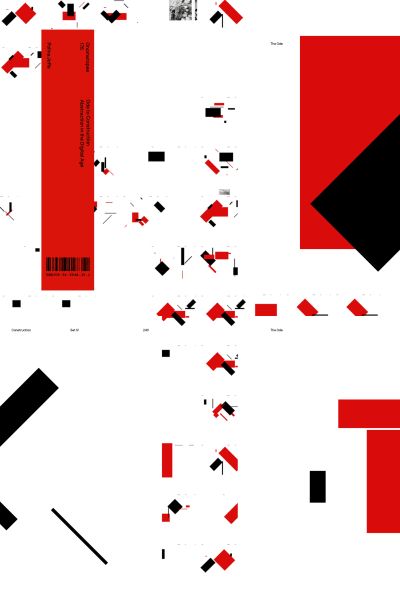Madeleine Morley, Max Boersma
Ode to Construction
Abstraction in the Digital Age
- Kategorie
- Bronze Medal
Begründung der Jury
★★
Finland /// Finnland
★★
“Each form is the frozen temporary image of a process. Thus, any work merely represents a way station in the process of becoming, and not a frozen goal.” El Lissitsky (on his work Proun Room)
Inspired by Russian Constructivism of the 1920s, this impressive work explores the intersections of graphic design and generative art. The book’s typography engages in a dialogue with geometric shapes created by code. The beautifully executed edge printing and the imposing redness of the work make for a convincing object that throws an ideal bridge to the content.
A project traversing both media and time extends across a printed book, a spatial installation, and a digital tool. A digital tool that is available online at odetoconstruction.com. Within several clicks, the site produces new constellations instantaneously, each iteration downloadable as an image file and printable at home.
Re-exploring the Suprematist movements – that had a very strong influence on De Stijl, Bauhaus and many others – the book draws on history while simultaneously utilizing contemporary technological possibilities. Via “Ode to Construction” Polina Joffe questions medium and context: What happens when a construction turns from code to print, or from code to space? What is lost? What stays the same?
★★
“Jede Form ist ein eingefrorenes, temporäres Bild eines Prozesses. Deshalb repräsentiert jegliches Werk lediglich ein Zwischenstadium vom Prozess des Heranwachsens, nicht das festgefahrene Ziel.” El Lissitsky (über seine Arbeit Proun Room)
Inspiriert vom russischen Konstruktivismus der 1920er Jahre, beschäftigt sich diese Publikation mit der Schnittstelle zwischen Grafikdesign und generativer Kunst. Die Typografie des Buches steht in Interaktion mit geometrischen Formen, die mit Hilfe von Code entwickelt wurden. Auch das Buch als Gesamtwerk spiegelt diesen Ansatz wider: die rote Randbedruckung und der rote Umschlag verwandeln das Buch in einen roten Quader – eine geometrische Form.
Das Projekt ist durch verschiedene Medien erfahrbar: als gedrucktes Buch, als Rauminstallation und als digitale Anwendung. Letztere können Sie selbst unter odetoconstruction.com testen und sich mit der Welt der generativen Kunst vertraut machen. Mit nur einem Klick produziert die Webseite sekundenschnell neue Konstellationen aus geometrischen Formen, die man im Nachgang als Bild herunterladen kann.
Durch diesen breiten Anwendungsbereich schafft die Publikation beides: eine Reise in die Vergangenheit durch die Geschichte der suprematistischen Bewegungen – welche großen Einfluss auf Gruppierungen wie De Stijl und das Bauhaus hatten – und eine Verortung in der Gegenwart mittels Nutzung der modernen Technik. Durch “Ode to Construction” stellt Polina Joffe den Zusammenhang von Medium und Kontext in Frage: Was passiert, wenn eine Konstruktion von Code in Druck, oder von Code in Räumlichkeit übertragen wird? Was geht verloren? Was bleibt gleich?



